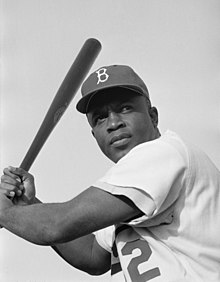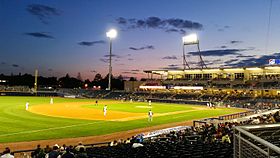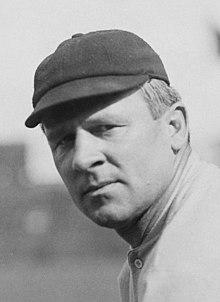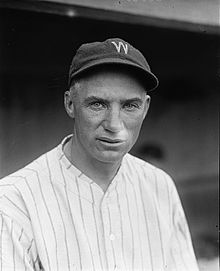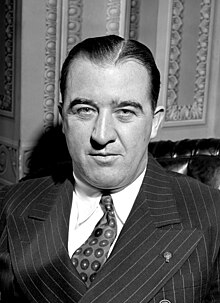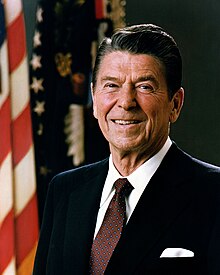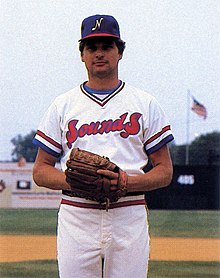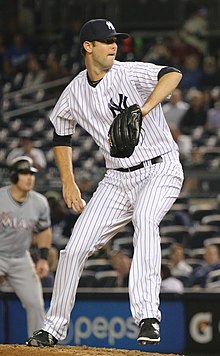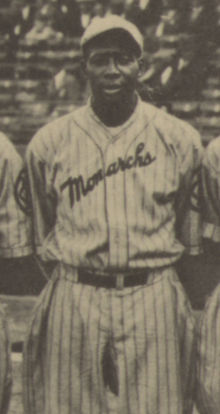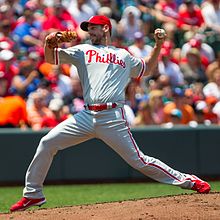Portal:Baseball
Portal maintenance status: (June 2018)
|
| Main page | Content, Categories & Topics | WikiProjects & Things you can do |
The Baseball Portal
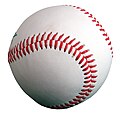
Baseball is a bat-and-ball sport played between two teams of nine players each, taking turns batting and fielding. The game occurs over the course of several plays, with each play generally beginning when a player on the fielding team, called the pitcher, throws a ball that a player on the batting team, called the batter, tries to hit with a bat. The objective of the offensive team (batting team) is to hit the ball into the field of play, away from the other team's players, allowing its players to run the bases, having them advance counter-clockwise around four bases to score what are called "runs". The objective of the defensive team (referred to as the fielding team) is to prevent batters from becoming runners, and to prevent runners' advance around the bases. A run is scored when a runner legally advances around the bases in order and touches home plate (the place where the player started as a batter).
The opposing teams switch back and forth between batting and fielding; the batting team's turn to bat is over once the fielding team records three outs. One turn batting for each team constitutes an inning. A game is usually composed of nine innings, and the team with the greater number of runs at the end of the game wins. Most games end after the ninth inning, but if scores are tied at that point, extra innings are usually played. Baseball has no game clock, though some competitions feature pace-of-play regulations such as the pitch clock to shorten game time.
Baseball evolved from older bat-and-ball games already being played in England by the mid-18th century. This game was brought by immigrants to North America, where the modern version developed. Baseball's American origins, as well as its reputation as a source of escapism during troubled points in American history such as the American Civil War and the Great Depression, have led the sport to receive the moniker of "America's Pastime"; since the late 19th century, it has been unofficially recognized as the national sport of the United States, though in modern times is considered less popular than other sports, such as American football. In addition to North America, baseball spread throughout the rest of the Americas and the Asia–Pacific in the 19th and 20th centuries, and is now considered the most popular sport in parts of Central and South America, the Caribbean, and East Asia, particularly in Japan, South Korea, and Taiwan. (Full article...)
 Featured articles - load new batch
Featured articles - load new batch
-
Image 1
Jack Roosevelt Robinson (January 31, 1919 – October 24, 1972) was an American professional baseball player who became the first African-American to play in Major League Baseball (MLB) in the modern era. Robinson broke the color line when he started at first base for the Brooklyn Dodgers on April 15, 1947. The Dodgers signing Robinson heralded the end of racial segregation in professional baseball, which had relegated black players to the Negro leagues since the 1880s.
Born in Cairo, Georgia, Robinson was raised in Pasadena, California. A four-sport student athlete at Pasadena Junior College and the University of California, Los Angeles, he was better known for football than he was for baseball, becoming a star college player with the UCLA Bruins football team. Following his college career, Robinson was drafted for service during World War II but was court-martialed for refusing to sit at the back of a segregated Army bus, eventually being honorably discharged. Afterwards, he signed with the Kansas City Monarchs of the Negro leagues, where he caught the eye of Branch Rickey, general manager of the Brooklyn Dodgers, who thought he would be the perfect candidate for breaking the color line in MLB. (Full article...) -
Image 2

Ian Michael Chappell (born 26 September 1943) is a former cricketer who played for South Australia and Australia. Known as "Chappelli", he is considered as one of the greatest captains the game has seen. He captained Australia between 1971 and 1975 before taking a central role in the breakaway World Series Cricket organisation. Born into a cricketing family—his grandfather and brother also captained Australia—Chappell made a hesitant start to international cricket playing as a right-hand middle-order batsman and spin bowler. He found his niche when promoted to bat at number three. Chappell's blunt verbal manner led to a series of confrontations with opposition players and cricket administrators; the issue of sledging first arose during his tenure as captain, and he was a driving force behind the professionalisation of Australian cricket in the 1970s. He was the captain of the Australian squad which finished as runners-up at the 1975 Cricket World Cup.
John Arlott called him "a cricketer of effect rather than the graces". An animated presence at the batting crease, he constantly adjusted his equipment and clothing, and restlessly tapped his bat on the ground as the bowler ran in. Basing his game on a sound defence learned during many hours of childhood lessons, Chappell employed the drive and square cut to full effect. He had an idiosyncratic method of playing back and across to a ball of full length and driving wide of mid-on, but his trademark shot was the hook, saying "three bouncers an over should be worth 12 runs to me". A specialist slip fielder, he was the fourth player to take one hundred Test catches. (Full article...) -
Image 3
First Horizon Park, formerly known as First Tennessee Park, is a baseball park in downtown Nashville, Tennessee, United States. The home of the Triple-A Nashville Sounds of the International League, it opened on April 17, 2015, and can seat up to 10,000 people. It replaced the Sounds' former home, Herschel Greer Stadium, where the team played from its founding in 1978 through 2014.
The park was built on the site of the former Sulphur Dell, a minor league ballpark in use from 1885 to 1963. It is located between Third and Fifth Avenues on the east and west (home plate, the pitcher's mound, and second base are directly in line with Fourth Avenue to the stadium's north and south) and between Junior Gilliam Way and Harrison Street on the north and south. The Nashville skyline can be seen from the stadium to the south. (Full article...) -
Image 4
Kenesaw Mountain Landis (/ˈkɛnɪsɔː ˈmaʊntɪn ˈlændɪs/; November 20, 1866 – November 25, 1944) was an American jurist who served as a United States federal judge from 1905 to 1922 and the first commissioner of baseball from 1920 until his death. He is remembered for his resolution of the Black Sox Scandal, in which he expelled eight members of the Chicago White Sox from organized baseball for conspiring to lose the 1919 World Series and repeatedly refused their reinstatement requests. His iron rule over baseball in the near quarter-century of his commissionership is generally credited with restoring public confidence in the game.
Landis was born in Millville, Ohio. Raised in Indiana, he became a lawyer, and then personal secretary to Walter Q. Gresham, the new United States Secretary of State, in 1893. He returned to private practice after Gresham died in office. (Full article...) -
Image 5
Marcus Elmore Baldwin (October 29, 1863 – November 10, 1929), nicknamed "Fido" and "Baldy", was an American professional baseball pitcher who played seven seasons in Major League Baseball (MLB). In 346 career games, he pitched to a 154–165 win–loss record with 295 complete games. Baldwin set the single-season MLB wild pitches record with 83 that still stands today.
Born in Pittsburgh, Pennsylvania, Baldwin made his professional debut for a Cumberland, Maryland, team in 1883. Though signed by Chicago White Stockings president Albert Spalding to pitch against the St. Louis Browns in the 1886 World Series, Baldwin did not play after the Browns objected. He made his MLB debut for the White Stockings in 1887, when a writer for the Oshkosh Daily Northwestern called him the "swiftest pitcher in the National League" (NL). Released by Chicago player–manager Cap Anson, he signed with the Columbus Solons of the American Association (AA) in 1889, where he led the league in innings pitched (513+2⁄3), losses (34), strikeouts (368), and walks (274). (Full article...) -
Image 6
John Joseph McGraw (April 7, 1873 – February 25, 1934) was an American Major League Baseball (MLB) player and manager who was for almost thirty years manager of the New York Giants. He was also the third baseman of the pennant-winning 1890s Baltimore Orioles teams, noted for their innovative, aggressive play.
McGraw was born into poverty in Truxton, New York. He found an escape from his hometown and a bad family situation through baseball, beginning a quick rise through the minor leagues that led him to the Orioles at the age of 18. Under the tutelage of manager Ned Hanlon, the Orioles of the 1890s won three National League (NL) pennants; McGraw was one of the stalwarts of the team alongside Wee Willie Keeler, Hughie Jennings, and Wilbert Robinson. The Orioles perfected the hit and run play and popularized the Baltimore chop; they also sought to win by intimidating the opposing team and the umpire. (Full article...) -
Image 7

Cobb in 1913
During the 1912 baseball season, center fielder Ty Cobb of the Detroit Tigers was suspended for ten days after entering the spectator stands at New York's Hilltop Park during a game and physically assaulting Claude Lucker, a heckler. At the time, Cobb was among the biggest stars in the major leagues. American League president Ban Johnson suspended Cobb and fined him $50 ($1,600 in 2023).
Cobb had been Lucker's verbal target throughout the four-game series between the Tigers and New York Yankees. Facing a continued stream of insults and questioning about his racial ancestry, Cobb lost his temper in the fourth inning of the fourth game, on May 15, 1912. He raced into the stands, punching and kicking Lucker; Lucker had lost eight fingers in an industrial accident and could not defend himself. Cobb was ejected from the game. Johnson witnessed these events and suspended Cobb indefinitely. Since there were few protections for ballplayers at the time from insults and objects hurled by fans, many took Cobb's side, including his teammates. After defeating the Philadelphia Athletics on May 17, the Detroit players telegraphed Johnson that they would not play again until Cobb was reinstated; Johnson refused to do so. (Full article...) -
Image 8
Stanley Anthony Coveleski (born Stanislaus Kowalewski, July 13, 1889 – March 20, 1984) was an American right-handed pitcher in Major League Baseball who played for four American League (AL) teams between 1912 and 1928, primarily the Cleveland Indians. The star of the Indians pitching staff, he won over 20 games each year from the war-shortened 1918 season through 1921, leading the AL in shutouts twice and in strikeouts and earned run average (ERA) once each during his nine years with the club. The star of the 1920 World Series, he led the Indians to their first title with three complete-game victories, including a 3–0 shutout in the Game 7 finale. Traded to the Washington Senators after the 1924 season, he helped that club to its second AL pennant in a row with 20 victories against only 5 losses, including a 13-game winning streak, while again leading the league in ERA.
Coveleski followed in the footsteps of his brother Harry as a major league pitcher. But after making his debut with the Philadelphia Athletics in 1912, he was sidetracked by three more seasons in the minor leagues before joining the Indians in 1916, and won only 13 major league games before turning 27. Coveleski specialized in throwing the spitball, where the pitcher alters the ball with a foreign substance such as chewing tobacco. It was legal when his career began but prohibited in 1920, with Coveleski being one of 17 pitchers permitted to continue throwing the pitch. In 450 career games, Coveleski pitched 3,082 innings and posted a record of 215–142, with 224 complete games, 38 shutouts, and a 2.89 ERA. He set Cleveland records of 172 wins, 2,502+1⁄3 innings and 305 starts, which were later broken by Mel Harder and Willis Hudlin. He was inducted into the Baseball Hall of Fame in 1969. (Full article...) -
Image 9
Albert Benjamin "Happy" Chandler Sr. (July 14, 1898 – June 15, 1991) was an American politician from Kentucky. He represented Kentucky in the U.S. Senate and served as its 44th and 49th governor. Aside from his political positions, he also served as the second commissioner of baseball from 1945 to 1951 and was inducted into the Baseball Hall of Fame in 1982. His grandson, Ben Chandler, later served as congressman for Kentucky's Sixth District.
A multi-sport athlete during his college days at Transylvania College, Chandler briefly considered a career in professional baseball before deciding to pursue a law degree. After graduation, he entered politics and was elected as a Democrat to the Kentucky Senate in 1929. Two years later, he was elected lieutenant governor, serving under Governor Ruby Laffoon. Chandler and Laffoon disagreed on the issue of instituting a state sales tax and when Chandler, the presiding officer in the state senate, worked to block the legislation, Laffoon's allies in the General Assembly stripped him of many of his statutory powers. The tax then passed by a narrow margin. Knowing that Laffoon would try to select his own successor at the Democratic nominating convention, Chandler waited until Laffoon left the state—leaving Chandler as acting governor—and called the legislature into session to enact a mandatory primary election bill. The bill passed, and in the ensuing primary, Chandler defeated Laffoon's choice, Thomas Rhea. He then went on to defeat Republican King Swope by the largest margin of victory for a Kentucky gubernatorial race at that time. As governor, Chandler oversaw the repeal of the sales tax, replacing the lost revenue with new excise taxes and the state's first income tax. He also enacted a major reorganization of state government, realizing significant savings for the state. He used these savings to pay off the state debt and improve the state's education and transportation systems. (Full article...) -
Image 10
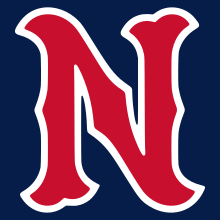
The Nashville Sounds are a Minor League Baseball team of the International League and the Triple-A affiliate of the Milwaukee Brewers. They are located in Nashville, Tennessee, and are named for the city's association with the music industry, specifically the "Nashville sound", a subgenre of country music which originated in the city in the mid-1950s. The team plays their home games at First Horizon Park, which opened in 2015 on the site of the historic Sulphur Dell ballpark. The Sounds previously played at Herschel Greer Stadium from its opening in 1978 until the end of the 2014 season. They are the oldest active professional sports franchise in Nashville.
Established as an expansion team of the Double-A Southern League in 1978, the Sounds led all of Minor League Baseball in attendance in their inaugural season and continued to draw the Southern League's largest crowds in each of their seven years as members. On the field, the team won six consecutive second-half division titles from 1979 to 1984 and won the Southern League championship twice: in 1979 as the Double-A affiliate of the Cincinnati Reds and again in 1982 as the Double-A affiliate of the New York Yankees. (Full article...) -
Image 11
Ronald Wilson Reagan (February 6, 1911 – June 5, 2004) was an American politician and actor who served as the 40th president of the United States from 1981 to 1989. A member of the Republican Party, he became an important figure in the American conservative movement, and his presidency is known as the Reagan era.
Born and raised in Illinois, Reagan graduated from Eureka College in 1932 and was hired the next year as a sports broadcaster in Iowa. In 1937, he moved to California where he became a well-known film actor. During his acting career, Reagan was elected president of the Screen Actors Guild twice, serving from 1947 to 1952 and from 1959 to 1960. In the 1950s, he became the host for General Electric Theater and also worked as a motivational speaker for General Electric. Subsequently, Reagan's "A Time for Choosing" speech during the 1964 U.S. presidential election launched his rise as a leading conservative figure. After being elected governor of California in 1966, he raised the state taxes, turned the state budget deficit into a surplus and implemented harsh crackdowns on university protests. Following his loss to Gerald Ford in the 1976 Republican Party presidential primaries, Reagan won the Republican Party's nomination and then a landslide victory over President Jimmy Carter in the 1980 presidential election. (Full article...) -
Image 12

On July 10, 1932, the Philadelphia Athletics beat the Cleveland Indians 18–17 in 18 innings in a Major League Baseball game played at League Park in Cleveland. Several major-league records were set during the game; for example, Johnny Burnett of the Indians became the only player to hit safely nine (or even eight) times in a game, while Cleveland's 33 hits and the teams' combined 58 hits are also single-game records. Pitcher Eddie Rommel secured the win for the Athletics, pitching an American League-record 17 innings in relief after Philadelphia's Lew Krausse gave up three runs in the first inning. The 29 hits Rommel allowed are a major-league record; the 14 runs against him are the most given up by a winning pitcher.
Coming into the game, the Athletics, who were the three-time defending American League champions, trailed the New York Yankees in the standings by 71⁄2 games. Sunday baseball was still illegal in Philadelphia, forcing the Athletics to make one-game road trips on some Sundays, including July 10. With his pitching staff exhausted by six games in the previous three days, the owner and manager of the Athletics, Connie Mack, took only two pitchers on the train trip to Cleveland, giving the rest of the staff the day off. With no chance of being relieved except by a position player, Rommel pitched with mixed effectiveness, giving up six runs in the seventh inning but only two runs in the final nine innings of the game. He aided his own cause by getting three hits in seven at bats. Cleveland's Wes Ferrell took the loss after Jimmie Foxx got his sixth hit of the game and then scored. Foxx had already batted in eight runs, having hit three home runs and accumulated sixteen total bases, tying a record that has since been broken. (Full article...) -
Image 13
A picture of a Wii Sports disc
Wii Sports is a 2006 sports simulation video game developed and published by Nintendo for the Wii video game console. The game was released in North America along with the Wii on November 19, 2006, and in Japan, Australia, and Europe the following month. It was included as a pack-in game with the console in all territories except Japan, making it the first sports game included with the launch of a Nintendo system since Mario's Tennis for the Virtual Boy in 1995. The game was later released on its own as part of the Nintendo Selects collection of games.
Wii Sports is a collection of five sports simulations designed to demonstrate the motion-sensing capabilities of the Wii Remote. The five sports included are tennis, baseball, bowling, golf, and boxing. Players use the Wii Remote to mimic actions performed in real-life sports, such as swinging a tennis racket or rolling a bowling ball. The rules for each game are simplified to make them more accessible to new players. The game also features training and fitness modes that monitor players' progress in the sports. (Full article...) -
Image 14Los Angeles Angels center fielder Mike Trout hits a home run on a pitch from New York Mets pitcher Tommy Milone on May 21, 2017.
Baseball is a bat-and-ball sport played between two teams of nine players each, taking turns batting and fielding. The game occurs over the course of several plays, with each play generally beginning when a player on the fielding team, called the pitcher, throws a ball that a player on the batting team, called the batter, tries to hit with a bat. The objective of the offensive team (batting team) is to hit the ball into the field of play, away from the other team's players, allowing its players to run the bases, having them advance counter-clockwise around four bases to score what are called "runs". The objective of the defensive team (referred to as the fielding team) is to prevent batters from becoming runners, and to prevent runners' advance around the bases. A run is scored when a runner legally advances around the bases in order and touches home plate (the place where the player started as a batter).
The initial objective of the batting team is to have a player reach first base safely; this generally occurs either when the batter hits the ball and reaches first base before an opponent retrieves the ball and touches the base, or when the pitcher persists in throwing the ball out of the batter's reach. Players on the batting team who reach first base without being called "out" can attempt to advance to subsequent bases as a runner, either immediately or during teammates' turns batting. The fielding team tries to prevent runs by using the ball to get batters or runners "out", which forces them out of the field of play. The pitcher can get the batter out by throwing three pitches which result in strikes, while fielders can get the batter out by catching a batted ball before it touches the ground, and can get a runner out by tagging them with the ball while the runner is not touching a base. (Full article...) -
Image 15Paschal before a game during the 1925 New York Yankees season
Benjamin Edwin Paschal (October 13, 1895 – November 10, 1974) was an American baseball outfielder who played eight seasons in Major League Baseball from 1915 to 1929, mostly for the New York Yankees. After two "cup of coffee" stints with the Cleveland Indians in 1915 and the Boston Red Sox in 1920, Paschal spent most of his career as the fourth outfielder and right-handed pinch hitter of the Yankees' Murderers' Row championship teams of the late 1920s. Paschal is best known for hitting .360 in the 1925 season while standing in for Babe Ruth, who missed the first 40 games with a stomach ailment.
During his time in baseball, Paschal was described as a five-tool player who excelled at running, throwing, fielding, hitting for average, and power. However, his playing time with the Yankees was limited because they already had future Baseball Hall of Famers Ruth and Earle Combs, and star Bob Meusel, in the outfield. Paschal was considered one of the best bench players in baseball during his time with the Yankees, and sportswriters wrote how he would have started for most other teams in the American League. He was one of the best pinch hitters in the game during the period, at a time when the term was still relatively new to baseball. (Full article...)
General images - load new batch
-
Image 1An Afghan girl playing baseball in August 2002 (from Baseball)
-
Image 31906 World Series, infielders playing "in" for the expected bunt and the possible play at the plate with the bases loaded (from Baseball rules)
-
Image 4Cover of Official Base Ball Rules, 1921 edition, used by the American League and National League (from Baseball rules)
-
Image 52013 World Baseball Classic championship match between the Dominican Republic and Puerto Rico, March 20, 2013 (from Baseball)
-
Image 6Sadaharu Oh managing the Japan national team in the 2006 World Baseball Classic. Playing for the Central League's Yomiuri Giants (1959–80), Oh set the professional world record for home runs. (from Baseball)
-
Image 8Pitchers are generally substituted during mound visits (team gatherings at the pitcher's mound). (from Baseball rules)
-
Image 10Alexander Cartwright, father of modern baseball (from History of baseball)
-
Image 13Two players on the baseball team of Tokyo, Japan's Waseda University in 1921 (from Baseball)
-
Image 14A pitcher handing off the ball after being taken out of the game during a mound meeting. (from Baseball)
-
Image 15A New York Yankees batter (Andruw Jones) and a Boston Red Sox catcher at Fenway Park (from Baseball)
-
Image 16By the 1860s Civil War, baseball (bottom) had overtaken its fellow bat-and-ball sport cricket (top) in popularity within the United States. (from History of baseball)
-
Image 17Pesäpallo, a Finnish variation of baseball, was invented by Lauri "Tahko" Pihkala in the 1920s, and after that, it has changed with the times and grown in popularity. Picture of Pesäpallo match in 1958 in Jyväskylä, Finland. (from Baseball)
-
Image 18Jackie Robinson in 1945, with the era's Kansas City Royals, a barnstorming squad associated with the Negro American League's Kansas City Monarchs (from History of baseball)
-
Image 19Rickey Henderson—the major leagues' all-time leader in runs and stolen bases—stealing third base in a 1988 game (from Baseball)
-
Image 20Fenway Park, home of the Boston Red Sox. The Green Monster is visible beyond the playing field on the left. (from Baseball)
-
Image 22Defensive positions on a baseball field, with abbreviations and scorekeeper's position numbers (not uniform numbers) (from Baseball)
-
Image 23The NL champion New York Giants baseball team, 1913. Fred Merkle, sixth in line, had committed a baserunning gaffe in a crucial 1908 game that became famous as Merkle's Boner. (from History of baseball)
-
Image 24Diagram of a baseball field Diamond may refer to the square area defined by the four bases or to the entire playing field. The dimensions given are for professional and professional-style games. Children often play on smaller fields. (from Baseball)
-
Image 26In May 2010, the Philadelphia Phillies' Roy Halladay pitched the 20th major league perfect game. That October, he pitched only the second no-hitter in MLB postseason history. (from History of baseball)
-
Image 27A runner sliding into home plate and scoring. (from Baseball)
-
Image 28Sadaharu Oh managing the Japan national team in the 2006 World Baseball Classic. Playing for the Central League's Yomiuri Giants (1959–80), Oh set the professional world record for home runs with 868. (from History of baseball)
-
Image 29Pick-off attempt on runner (in red) at first base (from Baseball rules)
-
Image 31A first baseman receives a pickoff throw, as the runner dives back to first base. (from Baseball)
-
Image 32Japanese-Americans spectating a World War II-era game while in an internment camp. America's ties to immigrants and to Japan have been deeply shaped by a shared baseball heritage. (from History of baseball)
-
Image 33The typical motion of a right-handed pitcher (from Baseball rules)
-
Image 34Baserunners generally stand a short distance away from their base between pitches, preparing themselves to either go back or steal the next base. (from Baseball rules)
-
Image 35The strike zone, which determines the outcome of most pitches, varies in vertical length depending on the batter's typical height while swinging. (from Baseball rules)
-
Image 36Cy Young—the holder of many major league career marks, including wins and innings pitched, as well as losses—in 1908. MLB's annual awards for the best pitcher in each league are named for Young. (from Baseball)
-
Image 37A game from the Cantigas de Santa Maria, c. 1280, involving tossing a ball, hitting it with a stick and competing with others to catch it (from History of baseball)
-
Image 38Jackie Robinson in 1945, with the era's Kansas City Royals, a barnstorming squad associated with the Negro American League's Kansas City Monarchs (from Baseball)
-
Image 39The American Tobacco Company's line of baseball cards featured shortstop Honus Wagner of the Pittsburgh Pirates from 1909 to 1911. In 2007, the card shown here sold for $2.8 million. (from Baseball)
-
Image 40Baseball games sometimes end in a walk-off home run, with the batting team usually gathering at home plate to celebrate the scoring of the winning run(s). (from Baseball rules)
-
Image 41A well-worn baseball (from Baseball)
-
Image 42The standard fielding positions (from Baseball rules)
-
Image 43The strike zone determines the result of most pitches, and varies in vertical length for each batter. (from Baseball)
-
Image 44A batter follows through after swinging at a pitched ball. (from Baseball rules)
 Good articles - load new batch
Good articles - load new batch
-
Image 1Wever with the Nashville Sounds in 1982
Stefan Matthew Wever (April 22, 1958 – December 27, 2022) was a German-born American professional baseball pitcher, who played a single Major League Baseball game with the New York Yankees in 1982, recording the loss, a 27.00 earned run average (ERA), and two strikeouts in that game.
Born in West Germany, Wever moved to the United States as a child and began playing baseball. He played in high school and the University of California, Santa Barbara, which led to him being drafted by the New York Yankees. After four seasons in the minor leagues, Wever made his major league debut on September 17, 1982. In his debut, he suffered a shoulder injury, which he tried to pitch through for two years before having surgery in 1984. He tried to come back from the injury in 1985 but retired. After retiring, he opened a bar in San Francisco, which he continued to run. (Full article...) -
Image 2
Herbert Eugene Plews (June 14, 1928 – December 12, 2014) was an American Major League Baseball second baseman. He played four years in the majors, from 1956 to 1959 with the Washington Senators and in 1959 for the Boston Red Sox. In the minor leagues he played for Kansas City, Binghamton, Norfolk, and Denver before reaching the majors in 1956, and Toronto, Birmingham, Hawaii, Tacoma, and Arkansas after his major league career ended. During his playing career he served in the military from 1951 to 1952, during the Korean War. Plews batted left-handed and threw right-handed; he was listed as 5 feet 11 inches (1.80 m) tall and 160 pounds (73 kg).
Born in East Helena, Montana, Plews would be (at the time of his death) the only player from the Helena area to reach the major leagues. After four years at the University of Illinois at Urbana-Champaign, he signed with the New York Yankees in 1950. Plews's time in the minor leagues was interrupted by his military service, but he had made it to the Denver Bears (the top affiliate of the Yankees' system) by 1955. After the season, though, he was sent to the Senators in a multi-player trade. Plews debuted with Washington in 1956 and started at second base for them over much of the next three years. Mostly a part-time player in 1959, he was traded to the Red Sox in July, appearing in just 13 more games before being sent to the minors. He played six more years of professional baseball before retiring at the end of 1965. After his baseball career, Plews worked in cement plants, first in Montana and then in the Denver area. He died in 2014. (Full article...) -
Image 3DeGrom with the New York Mets in 2020
Jacob Anthony deGrom (born June 19, 1988) is an American professional baseball pitcher for the Texas Rangers of Major League Baseball (MLB). He has previously played in MLB for the New York Mets.
DeGrom began playing baseball as a shortstop and was converted into a pitcher during his junior year at Stetson University. The Mets selected him in the ninth round of the 2010 MLB draft, and made his major league debut with them on May 15, 2014. That same year, deGrom was named the National League's (NL) Rookie of the Month twice, and the NL Rookie of the Year. In 2015, 2018, 2019, and 2021 deGrom was selected as an MLB All-Star. In 2018, deGrom was the NL leader in earned run average and won the Cy Young Award. In 2019, he led the NL in strikeouts and won the Cy Young Award for the second year in a row. In 2020, he again led the National League in strikeouts. (Full article...) -
Image 4
John William Heisman (/ˈhaɪzmən/ HYZE-mən; October 23, 1869 – October 3, 1936) was a player and coach of American football, baseball, and basketball, as well as a sportswriter and actor. He served as the head football coach at Oberlin College, Buchtel College (now known as the University of Akron), Auburn University, Clemson University, Georgia Tech, the University of Pennsylvania, Washington & Jefferson College, and Rice University, compiling a career college football record of 186–70–18.
Heisman was also the head basketball coach at Georgia Tech, tallying a mark of 9–14, and the head baseball coach at Buchtel, Clemson, and Georgia Tech, amassing a career college baseball record of 199–108–7. He served as the athletic director at Georgia Tech and Rice. While at Georgia Tech, he was also the president of the Atlanta Crackers baseball team. (Full article...) -
Image 5Martin with the New York Yankees in 2015
Christopher Riley Martin (born June 2, 1986) is an American professional baseball pitcher who is a free agent. He has played in Major League Baseball (MLB) for the Colorado Rockies, New York Yankees, Texas Rangers, Atlanta Braves, Chicago Cubs, Los Angeles Dodgers and Boston Red Sox and in Nippon Professional Baseball (NPB) for the Hokkaido Nippon-Ham Fighters.
Martin played baseball at Arlington High School and McLennan Community College, but gave up on baseball after he suffered a shoulder injury. After working in a warehouse for three years, Martin began playing catch, and felt strong enough to try out for independent league baseball. After he pitched for the Grand Prairie AirHogs in 2010, the Boston Red Sox of MLB signed Martin in 2011. He pitched in Minor League Baseball for the Red Sox organization, until they traded him to the Rockies after the 2013 season. (Full article...) -
Image 6The Climax Series (クライマックスシリーズ, Kuraimakkusu Shirīzu) is the current annual playoff system implemented by Japan's Nippon Professional Baseball (NPB). It determines which team from the Central League (CL) and from the Pacific League (PL) will advance to compete for the championship in the Japan Series. After the creation of the NPB's two-league system in 1950, the PL experimented with three different playoff systems. In 2004, it implemented the postseason structure from which the Climax Series is based. After three seasons, the CL adopted the same system in 2007, creating the current, unified playoff format.
Both leagues play a regular season, after which the top three teams in each league compete against one another in a two-stage playoff. In the first stage, the teams that finish the regular season with the second- and third-best records play one another in a best-of-three series. The winners of these three-game series advance to the final stage to face each league's regular-season champion in a six-game series, which the regular-season champion starts with a one-game advantage. The winners of each league's final stage series compete against one another in that year's Japan Series. (Full article...) -
Image 7Greene with the Louisville Bats in 2021
Christian Hunter Greene (born August 6, 1999) is an American professional baseball pitcher for the Cincinnati Reds of Major League Baseball (MLB). The Reds selected him second overall in the 2017 MLB Draft.
Born in Los Angeles, California, Greene learned how to pitch at the Major League Baseball Urban Youth Academy in Compton. His fastball velocity was already 93 mph (150 km/h) during his first year at Notre Dame High School, and by the time he graduated in 2017, it was up to 102 mph (164 km/h). The Reds drafted Greene out of high school, and he joined their farm system rather than playing college baseball. Greene suffered an ulnar collateral ligament injury partway through the 2018 season and underwent Tommy John surgery the following year. The COVID-19 pandemic kept him from pitching for another year, but once he returned in 2021, he quickly rose through the minor leagues. (Full article...) -
Image 8
Matthew Thomas Holliday (born January 15, 1980) is an American former professional baseball left fielder. He played in Major League Baseball (MLB) from 2004 to 2018 for the Colorado Rockies, Oakland Athletics, St. Louis Cardinals, and New York Yankees. A World Series champion in 2011 with the Cardinals, Holliday played a key role in seven postseasons, including the Rockies' first-ever World Series appearance in 2007 and Cardinals' playoff success in the 2010s. His distinctions include a National League (NL) batting championship, the 2007 NL Championship Series Most Valuable Player Award (NLCS MVP), seven All-Star selections, and four Silver Slugger Awards. Other career accomplishments include 300 home runs, more than 2,000 hits, and batting over .300 eight times.
The Colorado Rockies selected Holliday in the seventh round of the 1998 MLB draft from high school in Oklahoma, where he also starred as a highly touted quarterback prospect. He debuted in MLB in 2004, becoming the Rockies' starting left fielder and a middle of the lineup presence. In 2006, he became the 19th player ever to reach 195 hits, 30 home runs, 45 doubles, 115 runs and 110 runs batted in (RBI) in one season. The next season, he won the NL batting title, September National League Player of the Month honors and NLCS MVP as the Rockies won 21 of 22 games at the end of the regular season and in the playoffs en route to their first World Series appearance. In the first of four consecutive NLCS appearances starting in 2011, he batted .435 with a .652 slugging percentage in the 2011 NLCS on his way to winning his first World Series ring with the Cardinals. In 2014, he became just the fifth player in MLB history to amass nine consecutive seasons of at least 20 home runs, 30 doubles, 75 RBI and 80 runs scored each season. (Full article...) -
Image 9Collins with the St. Louis Browns, 1922
Tharon Leslie "Pat" Collins (September 13, 1896 – May 20, 1960) was an American baseball catcher who played ten seasons in Major League Baseball (MLB). He played for the St. Louis Browns, New York Yankees and Boston Braves from 1919 to 1929. Collins batted and threw right-handed and also played five games at first base.
Collins played minor league baseball for the Joplin Miners until 1919, when he signed with the Browns. After spending six seasons with the organization, Collins spent a one-year sojourn in the minor leagues before he was traded to the Yankees, where he spent the next three years and played in the famous 1927 Murderers' Row lineup. At the conclusion of the 1928 season, he was traded to the Braves, with whom he played his last major league game on May 23, 1929. A two-time World Series champion, he is famous for being the only major league player to pinch hit and pinch run in the same game. (Full article...) -
Image 10
Philip Joseph Hughes (born June 24, 1986) is an American former professional baseball pitcher. He played in Major League Baseball (MLB) for the New York Yankees, Minnesota Twins, and San Diego Padres during a career that spanned from 2007 through 2018. Hughes stands 6 feet 5 inches (1.96 m) tall and weighs 240 pounds (110 kg). He was the Yankees' first-round pick in the 2004 MLB draft.
During his time in the Yankees' minor-league system, Hughes became one of the most highly anticipated prospects in baseball. He debuted in the major leagues in 2007 as a starting pitcher and quickly demonstrated his potential with a bid for a no-hitter in only his second MLB start. However, injury cut short his outing, as well as significant portions of his 2007 and 2008 seasons. Hughes began 2009 in the minors but later returned to the majors, eventually becoming a relief pitcher in June and pitching as a setup man for Mariano Rivera. Hughes excelled in the new role during the regular season. Despite his struggles in the postseason, Hughes won a championship with the Yankees in the 2009 World Series over the Philadelphia Phillies. (Full article...) -
Image 11

Adrian "Addie" Joss (April 12, 1880 – April 14, 1911), nicknamed "the Human Hairpin", was an American professional baseball pitcher. He pitched for the Cleveland Bronchos of Major League Baseball, later known as the Naps, between 1902 and 1910. Joss, who was 6 feet 3 inches (1.91 m) and weighed 185 pounds (84 kg), pitched the fourth perfect game in baseball history (which, additionally, was only the second of the modern era). His 1.89 career earned run average (ERA) is the second-lowest in MLB history, behind Ed Walsh, while his career WHIP of 0.968 is the lowest of all-time.
Joss was born and raised in Wisconsin, where he attended St. Mary's College (later part of Wyalusing Academy) in Prairie du Chien and the University of Wisconsin. He played baseball at St. Mary's and then played in a semipro league where he caught the attention of Connie Mack. Joss did not sign with Mack's team, but he attracted further major league interest after winning 19 games in 1900 for the Toledo Mud Hens. Joss had another strong season for Toledo in 1901. (Full article...) -
Image 12
Vincent John Velasquez (/vəˈlɑːskɛz/ veh-LAS-kehz; born June 7, 1992) is an American professional baseball pitcher who is a free agent. He has played in Major League Baseball (MLB) for the Houston Astros, Philadelphia Phillies, San Diego Padres, Chicago White Sox, and Pittsburgh Pirates.
Born in Montclair, California, Velasquez was a multi-sport athlete at Garey High School in Pomona. After bone spurs in his right elbow kept him from pitching and playing shortstop, he learned how to field left-handed. A growth spurt prior to his senior year of high school caused him to draw interest from the soccer and gridiron football teams, but Velasquez opted to focus on baseball on the advice of a scout for the Chicago White Sox. The Astros selected him in the second round of the 2010 MLB Draft, and Velasquez chose to pitch for them rather than honor his commitment to play college baseball as a shortstop for Cal State Fullerton. He was assigned to the Greeneville Astros in 2010, but underwent Tommy John surgery later that year and did not return to the field until 2012. He had a successful season with the Quad Cities River Bandits in 2013, but struggles during a three-game stretch with the Lancaster JetHawks inspired him to sharpen his curveball. The following year, he helped take the JetHawks to a California League championship title. (Full article...) -
Image 13
Charles Wilber Rogan, also known as "Bullet Joe" (July 28, 1893 – March 4, 1967), was an American pitcher, outfielder, and manager for the Kansas City Monarchs in the Negro baseball leagues from 1920 to 1938. Renowned as a two-way player who could both hit and pitch successfully, one statistical compilation shows Rogan winning more games than any other pitcher in Negro leagues history and ranking fourth highest in career batting average. He was elected to the Baseball Hall of Fame in 1998.
Rogan's early baseball career took place in the U.S. Army, where he played for a famous team in the all-black 25th Infantry. After joining the Kansas City Monarchs, he was the top pitcher and one of the best hitters on a team that won three pennants from 1923 to 1925 and the 1924 Colored World Series. He became a playing manager in 1926 and led his team to another league title in 1929. (Full article...) -
Image 14
Miguel Ángel Cuellar Santana (KWAY-ar; May 8, 1937 – April 2, 2010) was a Cuban professional baseball player. He played for 15 seasons in Major League Baseball as a left-handed pitcher in 1959 and from 1964 through 1977, most prominently as a member of the Baltimore Orioles who won the American League (AL) pennant in each of Cuellar's first three seasons with the team. During that time, Cuellar and the Orioles won the 1970 World Series. Cuellar also played for the Cincinnati Reds, St. Louis Cardinals, Houston Astros and California Angels.
Cuellar and Denny McLain each won the AL Cy Young Award in 1969, due to a tie in the voting. For the Orioles, Cuellar won 20-or-more games in a season four times from 1969 through 1974. Along with Jim Palmer, Dave McNally, and Pat Dobson, he was one of four Oriole starters to win at least 20 games in 1971. Cuellar, nicknamed "Crazy Horse" because of his superstitious nature, ranks among Baltimore's top five career leaders in wins (143), strikeouts (1,011), shutouts (30) and innings pitched (2,028). In 1982, Cuellar was inducted into the Baltimore Orioles Hall of Fame. (Full article...) -
Image 15
Clifton Phifer Lee (born August 30, 1978) is an American former professional baseball starting pitcher who played for 13 seasons in Major League Baseball (MLB). Between 2002 and 2014 he played for the Cleveland Indians, Philadelphia Phillies, Seattle Mariners, and Texas Rangers. During his career, Lee was a member of four All-Star teams, won the Cy Young Award, and had consecutive World Series appearances in 2009 and 2010 with the Phillies and Rangers.
Born and raised in Benton, Arkansas, Lee's 91 mph (146 km/h) fastball attracted the attention of MLB scouts during his senior year at Benton High School in 1997, but he rejected draft offers twice in order to play college baseball for Meridian Community College and later the Arkansas Razorbacks. Lee finally came to terms with the Expos after his selection in the fourth round of the 2000 MLB Draft, and he spent two years in their farm system before a trade to Cleveland in 2002. Lee made his MLB debut with his new team that year, and made his first opening day roster in 2004. His early years in Cleveland were marked by a number of temper flares, appearing to intentionally pitch at his opponents' heads and storming off of the mound, but by 2005, he was an established part of the Indians' starting rotation. The low point of his career, when he was sent back to the minor leagues in 2007, was followed by his Cy Young-winning season, during which he led the American League with a 2.54 earned run average and all of MLB with 22 wins. (Full article...)
Did you know (auto-generated) - load new batch

- ... that Genevieve Beacom became the first woman to pitch in the Australian Baseball League when she made her debut for the Melbourne Aces in 2022?
- ... that after the 1918 season, some Major League Baseball owners wanted the National Baseball Commission to be replaced by former president William Howard Taft?
- ... that baseball player Joey Marciano is a cousin of world heavyweight champion Rocky Marciano?
- ... that Major League Baseball pitcher Charlie Gray was billed as his team's pitcher "of six fingers and six toed fame" and called "a freak" by the Sporting Life?
- ... that Bill Duplissea has been said to have the "best eyes in baseball"?
- ... that Harry Booth played for, captained, and coached the Saint Joseph's Hawks baseball and men's basketball teams?
- ... that Salty Parker, who spent 60 years in organized baseball, described his lifelong love of the game as "a beautiful disease"?
- ... that in the 1932 baseball game in which pitcher Eddie Rommel won his last game, he pitched 17 innings in relief, an American League record?
Quotes
| Chicks do dig the long ball. Umpires dig ground balls and two-hour games. Chicks don't dig that. |
 Featured lists - load new batch
Featured lists - load new batch
-
Image 1
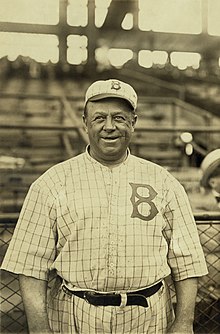
In baseball, a hit is credited to a batter when he reaches first base – or any subsequent base – safely after hitting a fair ball, without the benefit of an error or a fielder's choice. One hundred nineteen different players have recorded at least six hits in a single nine-inning Major League Baseball game. Five players have accomplished the feat more than once in their career; no player has ever recorded more than seven hits in a nine-inning game. Davy Force was the first player to collect six hits in a single game, doing so for the Philadelphia Athletics against the Chicago White Stockings on June 27, 1876.
These games have resulted in other single-game MLB records being set in connection with the prodigious offensive performance. Shawn Green, for example, established a new major league record with 19 total bases and finished with a total of five extra-base hits, tying a National League record that was also achieved by Larry Twitchell during the latter's six-hit game. Four of Green's six hits were home runs, equaling the record for most home runs in one game. Jim Bottomley, Walker Cooper, Anthony Rendon, and Wilbert Robinson hit 10 or more runs batted in (RBI) to complement their six hits. Robinson proceeded to collect a seventh hit and an eleventh RBI to set single-game records in both categories. Although his record of 11 RBIs has since been broken, Robinson's seven hits in a nine-inning game has been matched only by Rennie Stennett. (Full article...) -
Image 2

Tony Mullane made five Opening Day starts for the Reds during the 1800s.
The Cincinnati Reds are a Major League Baseball franchise based in Cincinnati who play in the National League's Central Division. In their history, the franchise also played under the names Cincinnati Red Stockings and Cincinnati Redlegs. They played in the American Association from 1882 through 1889, and have played in the National League since 1890. The first game of the new baseball season for a team is played on Opening Day, and being named the Opening Day starter is an honor that is often given to the player who is expected to lead the pitching staff that season, though there are various strategic reasons why a team's best pitcher might not start on Opening Day. The Reds have used 76 Opening Day starting pitchers since they began play as a Major League team in 1882.
The Reds have played in several different home ball parks. They played two seasons in their first home ball park, Bank Street Grounds, and had one win and one loss in Opening Day games there. The team had a record of six wins and ten losses in Opening Day games at League Park, and a record of three wins and seven losses in Opening Day games at the Palace of the Fans. The Reds played in Crosley Field from 1912 through the middle of the 1970 season, and had a record of 27 wins and 31 losses in Opening Day games there. They had an Opening Day record of 19 wins, 11 losses and 1 tie from 1971 through 2002 at Riverfront Stadium, and they have a record of three wins and six losses in Opening Day games at their current home ball park, the Great American Ball Park. That gives the Reds an overall Opening Day record of 59 wins, 66 losses and one tie at home. They have a record of three wins and one loss in Opening Day games on the road. (Full article...) -
Image 3

John Lackey was the Angels' Opening Day starting pitcher in 2003 and 2007.
The Los Angeles Angels are a Major League Baseball (MLB) franchise based in Anaheim, California. They play in the American League West division. The franchise has also gone by the names "Los Angeles Angels", "California Angels" and "Anaheim Angels" at various points in its history. The first game of the new baseball season for a team is played on Opening Day, and being named the Opening Day starter is an honor, which is often given to the player who is expected to lead the pitching staff that season, though there are various strategic reasons why a team's best pitcher might not start on Opening Day. The Angels have used 25 different Opening Day starting pitchers in their 51 seasons. The 25 starters have a combined Opening Day record of 26 wins, 18 losses and 7 no decisions. No decisions are awarded to the starting pitcher if the game is won or lost after the starting pitcher has left the game. It can also result if a starting pitcher does not pitch five full innings, even if his team retains the lead and wins.
Jered Weaver has the most Opening Day starts for the Angels, with seven, and had 6 consecutive opening day starts from 2010 to 2015. He has a record of three wins and two losses, with one no decision in those starts that resulted in a win. Mike Witt has the second most starts, with five, with one win, three losses, and one no decision that resulted in a loss. Frank Tanana, Mark Langston and Chuck Finley have all made four Opening Day starts for the Angels. Hall of Famer Nolan Ryan, Bartolo Colón and Jered Weaver have each made three such starts for the Angels. (Full article...) -
Image 4Johnny Podres, inaugural winner in 1955 for the Brooklyn Dodgers
The Willie Mays World Series Most Valuable Player (MVP) Award is given to the Major League Baseball (MLB) player deemed to have the most impact on his team's performance in the World Series, which is the final round of the MLB postseason. The award was first presented in 1955 by Sport magazine, but since 1985 has been officially presented by MLB. The winner is determined during the final game of the World Series by a committee of reporters and officials present at the game.
On September 29, 2017, the award was renamed in honor of Willie Mays in remembrance of the 63rd anniversary of The Catch, which occurred the year before the award's debut; Mays never won the award himself. (Full article...) -
Image 5

Josh Beckett (1999) won a World Series ring with the Marlins in 2003 and then with the Boston Red Sox in 2007.
The Miami Marlins are a Major League Baseball (MLB) franchise based in Miami, Florida. They play in the National League East division. Since the franchise was established in 1993 as the Florida Marlins, the Marlins have selected 35 players in the first round. Officially known as the "First-Year Player Draft", the Rule 4 Draft is MLB's primary mechanism for assigning players from high schools, colleges, and other amateur clubs to its franchises. The draft order is determined based on the previous season's standings, with the team possessing the worst record receiving the first pick. In addition, teams which lost free agents in the previous off-season may be awarded compensatory or supplementary picks. The First-Year Player Draft is unrelated to the 1992 expansion draft in which the Marlins filled their roster.
Of the 35 players picked in the first round by the Marlins, 20 have been pitchers, the most of any position; 11 of these were right-handed, while nine were left-handed. Six outfielders were selected and three players each were taken at first base, third base, and catcher. The Marlins have also drafted one shortstop in the first round, though they have never taken a second baseman. Seven of the players came from high schools or universities in the state of California; Florida and Texas schools each produced four players; and Louisiana schools produced three. (Full article...) -
Image 6

Reggie Jackson (1966) won three World Series titles with the A's and was elected to the Baseball Hall of Fame in 1993.
The Oakland Athletics (the A's) are a Major League Baseball (MLB) franchise based in Oakland, California. They play in the American League West division. The Athletics had played in Philadelphia from 1901 to 1954 and then Kansas City from 1955 to 1967 before moving to Oakland. Since the establishment of the Rule 4 Draft the Athletics have selected 82 players in the first round. Officially known as the "First-Year Player Draft", the Rule 4 Draft is MLB's primary mechanism for assigning players from high schools, colleges, and other amateur clubs to its franchises. The draft order is determined based on the previous season's standings, with the team possessing the worst record receiving the first pick. In addition, teams which lost free agents in the previous off-season may be awarded compensatory or supplementary picks.
Of these 82 players, 36 have been pitchers, the most of any position; 27 of these were right-handed, while 9 were left-handed. Fifteen outfielders, including one center fielder, and 14 shortstops were selected. The A's have also drafted seven catchers, five third basemen, four first basemen, and one second baseman in the first round. Additionally, 23 players came from high schools or universities in the A's home state of California, followed by 10 from Texas and Florida. They also drafted Ariel Prieto in 1995, who had defected from Cuba the year before. Prieto made his major league debut in 1995, one of 20 players in draft history to go directly to the majors without playing in the minor leagues. (Full article...) -
Image 7

Roy Halladay is the only pitcher in Phillies history to throw multiple no-hit games with the team: a perfect game in May 2010; and a postseason no-hitter in October of that year.
The Philadelphia Phillies are a Major League Baseball franchise based in Philadelphia. They play in the National League East division. Also known in their early years as the "Philadelphia Quakers", pitchers for the Phillies have thrown fourteen separate no-hitters in franchise history. A no-hitter is officially recognized by Major League Baseball only "when a pitcher (or pitchers) allows no hits during the entire course of a game, which consists of at least nine innings", though one or more batters "may reach base via a walk, an error, a hit by pitch, a passed ball or wild pitch on strike three, or catcher's interference". No-hitters of less than nine complete innings were previously recognized by the league as official; however, several rule alterations in 1991 changed the rule to its current form.
Of the fourteen no-hitters pitched by Phillies players, three have been won by a score of 6–0, and three by a score of 1–0, more common than any other results. The largest margin of victory in a Phillies no-hitter was ten runs, in a 10–0 win by Chick Fraser. Charlie Ferguson's no-hitter, the first in franchise history, was a 1–0 victory, as were two of the more recent regular season no-hitters, thrown by Kevin Millwood in 2003 and Roy Halladay in 2010. Three pitchers to throw no-hitters for the Phillies have been left-handed: Johnny Lush (in 1906), Terry Mulholland (in 1990) and Cole Hamels (in 2015). The other nine pitchers were right-handed. Halladay is the only Phillies' pitcher to throw more than one no-hitter in a Phillies uniform, and others, including Hall of Famer Jim Bunning, have pitched more than one in their careers. The longest interval between Phillies no-hitters was between the games pitched by Lush and Bunning, encompassing 58 years, 1 month, and 20 days from May 1, 1906 to June 21, 1964. Conversely, the shortest interval between no-hitters was between Halladay's two 2010 no-hitters, with a total of merely four months and seven days from May 29 to October 6; the shortest gap between regular-season no-hitters was between Mulholland's and Tommy Greene's games (nine months and eight days from August 15, 1990 to May 23, 1991). Two opponents have been no-hit by the Phillies more than one time: the San Francisco Giants, who were defeated by Mulholland (in 1990) and Millwood (in 2003); and the Cincinnati Reds, who were no-hit by Rick Wise (in 1971) and Halladay (in 2010). (Full article...) -
Image 8The Major League Baseball Comeback Player of the Year Award is presented by Major League Baseball (MLB) to the player who is judged to have "re-emerged on the baseball field during a given season." The award was developed in 2005, as part of a sponsorship agreement between MLB and Viagra. In 2005 and 2006 representatives from MLB and MLB.com selected six candidates each from the American (AL) and National Leagues (NL) and one winner for each league was selected via an online poll on MLB.com. Since then, the winners have been selected by a panel of MLB beat reporters. Under the current voting structure, first place votes are worth five points, second place votes worth three, and third place votes worth one with the award going to the player with the most points overall. Past winners have often overcome injury or personal problems en route to their award-winning season.
A Comeback Player of the Year Award has been given by The Sporting News since 1965 but its results are not officially recognized by Major League Baseball. Since the beginning of the MLB award in 2005, the recipients have been identical with the following exceptions: 2008 NL (TSN honored Fernando Tatís, MLB honored Brad Lidge), 2010 AL (TSN honored Vladimir Guerrero, MLB honored Francisco Liriano), 2012 AL (TSN honored Adam Dunn, MLB honored Fernando Rodney), 2016 (TSN honored Jose Fernandez and Mark Trumbo, MLB honored Anthony Rendon and Rick Porcello), 2018 NL (TSN honored Matt Kemp, MLB honored Jonny Venters), 2019 AL (TSN honored Hunter Pence, MLB honored Carlos Carrasco), and 2020 AL (TSN honored Carrasco, MLB honored Salvador Pérez). Liriano and Posey are the only players to win the MLB award multiple times with Liriano being the first to win it in each league. (Full article...) -
Image 9

Ty Cobb won more batting titles than any other player, though the precise number is unclear because of the race in the 1910 American League.
In baseball, batting average (AVG) is a measure of a batter's success rate in achieving a hit during an at bat. In Major League Baseball (MLB), it is calculated by dividing a player's hits by his at bats (AB). In MLB, a player in each league[L] wins the "batting title" each season for having the highest batting average that year. The American League (AL) winner is known as the "Rod Carew American League Batting Champion", while the National League (NL) leader is designated the "Tony Gwynn National League Batting Champion". Since 1957, a player must have 3.1 plate appearances (PA) per scheduled game in that league (for a total of 502 over the current 162-game season) to qualify for the batting title. However, if a player's lead in AVG is sufficiently large that enough hitless at bats can be added to reach this requirement and the player still would have the highest batting average, he wins the title. Tony Gwynn, for example, had 159 hits in 451 ABs in 1996 (.353 average) but only 498 PAs. Gwynn's batting average would have dropped to .349 (159 hits in 455 ABs) with four hitless ABs added to reach the 502 PA requirement, but this would still have been higher than the next-highest eligible player (Ellis Burks with a .344 average), so he was awarded the 1996 NL batting title.
The first batting average champion in the NL was Ross Barnes; in the league's inaugural 1876 season, Barnes batted .429 for the Chicago White Stockings. The AL was established in 1901, and Hall of Fame second baseman Nap Lajoie led that league with a .426 average for the Philadelphia Athletics. Ty Cobb of the Detroit Tigers, who also holds the highest career batting average of .366, led the AL in average in 11 (or 12) seasons. Honus Wagner and Gwynn are tied for the second-most titles, with eight apiece in the NL. It is unclear whether Lajoie or Cobb won the 1910 AL title, with some sources attributing the title to each man.[1910a] If Cobb is credited with the 1910 title, he won 9 consecutive titles from 1907 to 1915 and 12 total titles for his career. Otherwise, Rogers Hornsby won the most consecutive titles, with six from 1920 to 1925. Without the 1910 title, Cobb still led the league in five consecutive seasons from 1911 to 1915. Cobb holds the record for highest average in two and three consecutive seasons (.414 from 1911 to 1912 and .408 from 1911 to 1913), but Hornsby holds the record for four and five consecutive seasons (.404 from 1922 to 1925 and .402 from 1921 to 1925). Wagner, Rod Carew, Wade Boggs, and Gwynn have each won four consecutive titles. Lajoie also had a streak of four league-leading seasons from 1901 to 1904 if he is credited with the contested AL title in 1902.[1902a] At the 2016 MLB All-Star Game in San Diego, MLB announced that the AL and NL batting champions would henceforth be named in honor of Carew and Gwynn, respectively. Gwynn won all eight titles in the NL with the San Diego Padres, while Carew was a seven-time AL batting champion. (Full article...) -
Image 10

Billy Conigliaro was the first player ever drafted by the Boston Red Sox, selected in the first round of the 1965 MLB draft. An outfielder, he played in MLB from 1969 through 1973.
The Boston Red Sox are a Major League Baseball (MLB) franchise based in Boston, Massachusetts. They play in the American League East division. This page lists prospects selected by the team in the first round of the annual Major League Baseball draft.
Officially known as the "First-Year Player Draft", the draft is MLB's primary mechanism for assigning amateur baseball players from high schools, colleges, and other amateur baseball clubs to its teams. The draft order is determined based on the previous season's standings, with the team possessing the worst record receiving the first pick. In addition, teams that lost free agents in the previous off-season may be awarded compensatory or supplementary picks. (Full article...) -
Image 11

Alex Cora (waving) is the most recent manager to lead the Red Sox to a World Series championship.
The Boston Red Sox are a professional baseball team based in Boston, Massachusetts. The Red Sox are members of the American League (AL) East Division in Major League Baseball (MLB). They have competed since 1901, initially as the Boston Americans (1901–1907), and under their current name since 1908. Since 1912, the Red Sox have played their home games at Fenway Park. In baseball, the head coach of a team is called the manager, or more formally, the field manager. There have been 48 different managers in franchise history; the current manager is Alex Cora, who previously managed the team during the 2018 and 2019 seasons and was re-hired by the team on November 6, 2020.
Jimmy Collins was the first manager of the franchise, managing from 1901 to 1906. Among all Red Sox managers, Joe Cronin managed the most regular season games (2,007) and registered the most regular season wins (1,071), while Terry Francona managed the most playoff games (45) and registered the most playoff wins (28). The most World Series championships won by a Red Sox manager is two, accomplished by Bill Carrigan (1915 and 1916) and Francona (2004 and 2007). John McNamara and Jimy Williams are the only two Red Sox managers to win the AL Manager of the Year Award, in 1986 and 1999, respectively. (Full article...) -
Image 12

Barry Larkin is the Silver Slugger Award leader among shortstops, with nine wins.
The Silver Slugger Award is awarded annually to the best offensive player at each position in both the American League (AL) and the National League (NL), as determined by the coaches and managers of Major League Baseball (MLB). These voters consider several offensive categories in selecting the winners, including batting average, slugging percentage and on-base percentage, in addition to "coaches' and managers' general impressions of a player's overall offensive value." Managers and coaches are not permitted to vote for players on their own team. The Silver Slugger was first awarded in 1980 and is given by Hillerich & Bradsby, the manufacturer of Louisville Slugger bats. The award is a bat-shaped trophy, 3 feet (91 cm) tall, engraved with the names of each of the winners from the league and plated with sterling silver.
Among shortstops, Barry Larkin is the leader in Silver Slugger Awards, with nine wins between 1988 and 1999, including five consecutive awards (1988–1992). Larkin is fourth all-time in Silver Slugger wins among all positions, behind outfielder Barry Bonds, catcher Mike Piazza and third baseman Alex Rodriguez, who won his first seven awards at shortstop before a position change. Hall of Famer Cal Ripken Jr. won eight Silver Sluggers as a shortstop from 1983 to 1993. Derek Jeter (2006–2009; 2012) and Xander Bogaerts (2015–2016; 2019; 2021–2022) each won five Silver Sluggers as a shortstop. Francisco Lindor collected four Silver Sluggers as a shortstop, winning two each in the American and National Leagues (2017–2018; 2023–2024) Ian Desmond (2012–2014), Alan Trammell (1987–1988, 1990), Édgar Rentería (2000; 2002–2003) and Corey Seager (2016–2017; 2023) each won three Silver Slugger Awards at shortstop, with Seager winning at least one Silver Slugger across both the American and National Leagues. (Full article...) -
Image 13The New York Yankees are a professional baseball team based in New York City, New York in the borough of The Bronx. The New York Yankees are members of the American League (AL) East Division in Major League Baseball (MLB). The Yankees have won the World Series 27 times, more than any other MLB team. In baseball, the head coach of a team is called the manager. The duties of the team manager include team strategy and leadership on and off the field. Since starting to play as the Baltimore Orioles (no relationship to the current Baltimore Orioles team) in 1901, the team has employed 35 managers. The current manager is Aaron Boone, the current general manager is Brian Cashman and the current owner is Hal Steinbrenner, the son of George Steinbrenner, who first bought the Yankees in 1973.
The franchise's first manager was Hall of Famer John McGraw, who managed the team for one year and part of a second before becoming manager of the New York Giants. In 1903, the team moved from Baltimore to New York, where it was initially known as the New York Highlanders. Its first manager in New York was Clark Griffith, who managed the team from 1903 to 1908. Miller Huggins was the next manager to manage the team for more than three seasons. Huggins took over the managerial duties in 1918 and led the Yankees to six American League championships and three World Series titles until his death in 1929. Huggins won 1,067 regular season games with the Yankees, which ranks fourth all-time among Yankee managers. (Full article...) -
Image 14
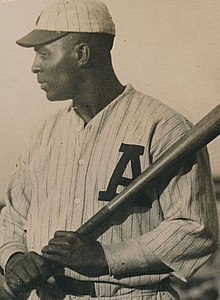
In baseball, batting average (AVG) is a measure of a batter's success rate in achieving a hit during an at bat, and is calculated by dividing a player's hits by his at bats. The achievement of a .400 batting average in a season was historically recognized as the coveted "standard of hitting excellence", in light of how batting .300 in a season is already regarded as very good. There have been 50 officially-recognized instances of a player have recorded a batting average of at least .400 in a single Major League Baseball (MLB) season, but none have done so since 1943, when Josh Gibson of the Homestead Grays hit .466, the single-season record. In the National League, the last to do so was Bill Terry of the New York Giants in 1930. Ted Williams of the Boston Red Sox is the last player to hit .400 in the American League. Four players – Ed Delahanty, Ty Cobb, Rogers Hornsby and Oscar Charleston – have accomplished the feat in three different seasons, Ross Barnes was the first player to bat .400 in a season, posting a .429 batting average in the National League's inaugural 1876 season.
In total, 36 players have reached the .400 mark in MLB history and seven have done so more than once. Of these, eighteen were left-handed batters, seventeen were right-handed, and one was a switch hitter, meaning they could bat from either side of the plate. Two of these players (Terry and Williams) played for only one major league team. The Philadelphia Phillies are the only franchise to have three players reach the milestone in the same season: Ed Delahanty, Billy Hamilton, Sam Thompson, all of whom Hall of Fame outfielders who attained a batting average over .400 during the 1894 season. The Homestead Grays are the only franchise with four players recording a .400 single-season batting average, albeit in different years: Joe Strong (1932), Josh Gibson (1937, 1943), Buck Leonard (1938) and David Whatley (1939) all hit .400 while playing for the Grays. Three players won the Most Valuable Player (MVP) Award in the same year as their .400 season: Ty Cobb (1911), George Sisler (1922) and Rogers Hornsby (1925). Rap Dixon, Tip O'Neill, Nap Lajoie, Josh Gibson (twice), Willie Wells, Mule Suttles, Oscar Charleston (twice), Heavy Johnson and Rogers Hornsby (twice) also earned the Triple Crown alongside achieving a .400 batting average, leading their respective leagues in batting average, home runs and runs batted in (RBI). Shoeless Joe Jackson of the Cleveland Naps hit .408 in 1911, the highest batting average ever recorded by a rookie in the American League. Joe Strong has the lowest career batting average among players who have batted .400 in a season with .266, while Gibson – with .372 – recorded the highest career average in major league history. (Full article...) -
Image 15

Ken Griffey Jr., the 1987 first overall draft pick
The first-year player draft, also known as the Rule 4 Draft, is the primary mechanism for assigning amateur baseball players from high schools, colleges, and other amateur baseball clubs to Major League Baseball (MLB) teams. Unlike most professional sports, MLB does not permit the trading of draft picks. Since 2023, the first six selections are determined by a lottery; the previous season's standings determine the remaining selections. If two teams have identical records, the team with the worse record in the previous season will receive the higher pick. In addition, teams that lost free agents in the previous off-season may be awarded "compensatory" picks. The first draft took place in 1965; it was introduced to prevent richer teams from negotiating wealthier contracts with top-level prospects and therefore, monopolizing the player market. Originally, three drafts were held each year. The first draft took place in June and involved high-school graduates and college seniors who had just finished their seasons. The second draft took place in January for high school and college players who had graduated in December. The third draft took place in August and was for players who participated in American amateur summer leagues. The August draft was eliminated after two years, and the January draft lasted until 1986.
In 1965, Rick Monday became MLB's first draft pick after being selected by the Kansas City Athletics. Travis Bazzana is the most recent first overall pick; he was drafted by the Cleveland Guardians in 2024. Overall, 23 of the 50 picks before 2015 have participated in the All-Star Game, and four (Bob Horner, Darryl Strawberry, Bryce Harper, and Carlos Correa) have won the Rookie of the Year Award. Twenty-five of the fifty picks before 2015 have been drafted from high schools, one has been drafted out of the Independent American Association, and the others were drafted from universities. To date, Arizona State University, Vanderbilt University, Louisiana State University, and Oregon State University are the only schools from which multiple number-one overall draft picks have been chosen. No first overall pick was inducted into the National Baseball Hall of Fame until 2016, when Ken Griffey Jr. was inducted with a record 99.3 percent of votes cast. Griffey has since been joined by three other top picks: Chipper Jones, inducted in 2018; Harold Baines, elected in December 2018 and inducted in July 2019, and Joe Mauer, inducted in 2024. (Full article...)
More did you know
- ...that on Mother's Day, May 14, 2006, the Louisville Slugger Company produced more than 400 pink baseball bats for game use by more than 50 professional baseball players?
- ... that the 12–6 curveball gets its name from the way the pitch breaks downward, looking like it moves from the number 12 to the number 6 on a clock?
- ... that Lou Marson hit his first major league home run on the final day of the Philadelphia Phillies’ World Series-winning 2008 season?
- ...that Jerry Dybzinski's baserunning error in game four of the 1983 American League Championship Series ultimately cost the Chicago White Sox both the game and the series?
- ... that Nick Castellanos received a $3.45 million signing bonus from the Detroit Tigers, the highest ever for a player not drafted in the first round in the Major League Baseball Draft?
Sports portals
Selected picture
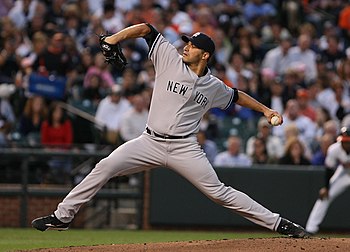
| Credit: Keith Allison |
Andrew Eugene "Andy" Pettitte; born June 15, 1972) is an American former baseball starting pitcher who played 18 seasons in Major League Baseball (MLB), primarily for the New York Yankees. He also pitched for the Houston Astros. Pettitte won five World Series championships with the Yankees and was a three-time All-Star. He ranks as MLB's all-time postseason wins leader with 19.
Associated Wikimedia
The following Wikimedia Foundation sister projects provide more on this subject:
-
Commons
Free media repository -
Wikibooks
Free textbooks and manuals -
Wikidata
Free knowledge base -
Wikinews
Free-content news -
Wikiquote
Collection of quotations -
Wikisource
Free-content library -
Wikiversity
Free learning tools -
Wiktionary
Dictionary and thesaurus
More portals
- Portals with triaged subpages from June 2018
- All portals with triaged subpages
- Portals with no named maintainer
- Automated article-slideshow portals with 51–100 articles in article list
- Automated article-slideshow portals with 501–1000 articles in article list
- Random portal component with 41–50 available subpages
- Automated article-slideshow portals with 201–500 articles in article list
- Random portal component with 11–15 available subpages
- Random portal component with 21–25 available image subpages



